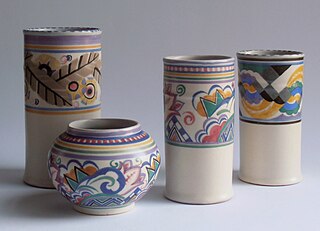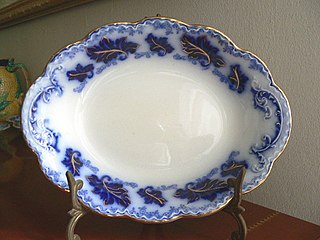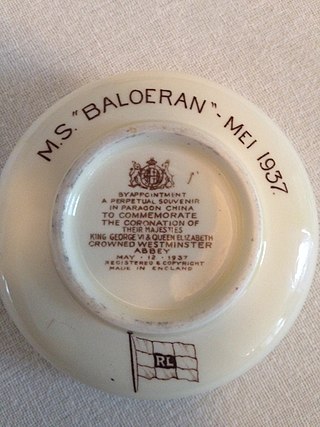
Sir Peter Markham Scott, was a British ornithologist, conservationist, painter, naval officer, broadcaster and sportsman. The only child of Antarctic explorer Robert Falcon Scott, he took an interest in observing and shooting wildfowl at a young age and later took to their breeding.

Clarice Cliff was an English ceramic artist and designer. Active from 1922 to 1963, Cliff became the head of the factory creative department.

Spode is an English brand of pottery and homewares produced by the company of the same name, which is based in Stoke-on-Trent, England. Spode was founded by Josiah Spode (1733–1797) in 1770, and was responsible for perfecting two extremely important techniques that were crucial to the worldwide success of the English pottery industry in the century to follow.

The Staffordshire Potteries is the industrial area encompassing the six towns Burslem, Fenton, Hanley, Longton, Stoke and Tunstall, which is now the city of Stoke-on-Trent in Staffordshire, England. North Staffordshire became a centre of ceramic production in the early 17th century, due to the local availability of clay, salt, lead and coal.

Poole Pottery is a British pottery brand. The name is now a brand, owned by Denby, with the products made in Stoke on Trent, Staffordshire.

Tunstall is one of the six towns that, along with Burslem, Longton, Fenton, Hanley and Stoke-upon-Trent, amalgamated to form the City of Stoke-on-Trent in Staffordshire, England. It was one of the original six towns that federated to form the city. Tunstall is the most northern, and fourth largest town of the Potteries. It is situated in the very northwest of the city borough, with its north and west boundaries being the city limit. It stands on a ridge of land between Fowlea Brook to the west and Scotia Brook to the east, surrounded by old tile-making and brick-making sites, some of which date back to the Middle Ages.
Portmeirion is a British pottery company based in Stoke-on-Trent, England. They specialise in earthenware tableware.

Johnson Brothers was a British tableware manufacturer and exporter that was noted for its early introduction of "semi-porcelain" tableware. It was among the most successful Staffordshire potteries which produced tableware, much of it exported to the United States, from the 1890s through to the 1960s. They were also important manufacturers of large bathroom ceramics. Some of its designs, such as "Eternal Beau", "Dawn", "Old Britain Castles" and "Historic America", achieved widespread popularity and are still collected today. The company's success was due in part to its ability to identify and follow trends that appealed to its customers in the United States, and in part to the high quality of its designs, produced by skilled artists.

Frederick Hurten Rhead (1880–1942) was a ceramicist and a major figure in the Arts and Crafts movement. A native of England, worked as a potter in the United States for most of his career. In addition to teaching pottery techniques, Rhead was highly influential in both studio and commercial pottery. He worked for the Roseville Pottery, established his own Rhead Pottery (1913–1917), and in 1935 designed the highly successful Fiesta ware for Homer Laughlin China Company.

Mintons was a major company in Staffordshire pottery, "Europe's leading ceramic factory during the Victorian era", an independent business from 1793 to 1968. It was a leader in ceramic design, working in a number of different ceramic bodies, decorative techniques, and "a glorious pot-pourri of styles - Rococo shapes with Oriental motifs, Classical shapes with Medieval designs and Art Nouveau borders were among the many wonderful concoctions". As well as pottery vessels and sculptures, the firm was a leading manufacturer of tiles and other architectural ceramics, producing work for both the Houses of Parliament and United States Capitol.

Wade Ceramics Ltd was a manufacturer of porcelain and earthenware, headquartered in Stoke-on-Trent, England. Its products include animal figures for its Collectors Club, whisky flagons, and a variety of industrial ceramics.

J. & G. Meakin was an English pottery manufacturing company founded in 1851 and based in Hanley, Stoke-on-Trent, Staffordshire.

The Paragon China Company was a British manufacturer of bone china from 1919 to 1960, based in Longton, Stoke-on-Trent, previously known as the Star China Company, and more recently part of the Royal Doulton group. Paragon was noted for producing high quality teaware and tableware, and was granted royal warrants of appointment by several members of the British Royal Family.
The Clayburn Pottery was an English pottery works based in Milner St, Hanley, Stoke-on-Trent.
Dorothy Jessie Tait was a prolific English ceramic designer working in the Stoke-on-Trent pottery industries, most prominently for Midwinter, from the 1940s to the 1980s.
Meakin is a surname. Notable people with the surname include:

Emma Bridgewater is a British ceramics manufacturing company founded in 1985. The company specialises in earthenware tableware, manufactured in Stoke-on-Trent, England. The pottery is produced using traditional techniques. The company is one of the largest pottery manufacturers based entirely in the UK.

W H Grindley was an English pottery company that made earthenware and ironstone tableware, including flow blue. The company was founded in 1880 by William Harry Grindley, JP of Tunstall, Stoke-on-Trent.
Gray's Pottery, also spelled as Grays Pottery and formally known as A.E. Gray Ltd. was a British pottery company based in Hanley, Staffordshire, later Stoke-upon-Trent, which existed until it was taken over by Portmeirion Pottery in 1960.
Flux Stoke-on-Trent is a spin-out company from Staffordshire University. Located in Stoke-on-Trent, traditional centre of the English pottery industry, it produces decorated bone china tableware that is manufactured in the city and primarily designed by students on its ceramics master's degree programme.

















